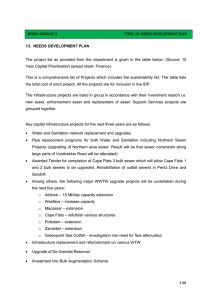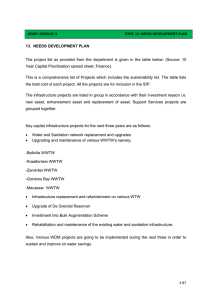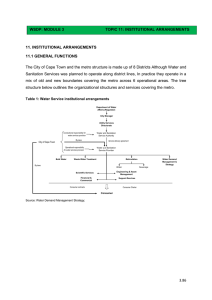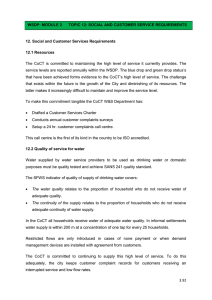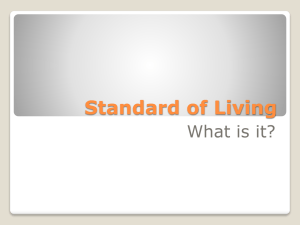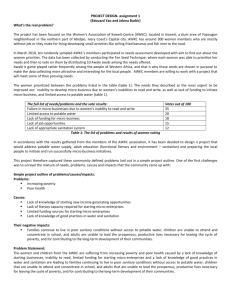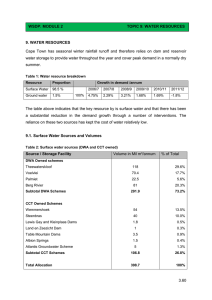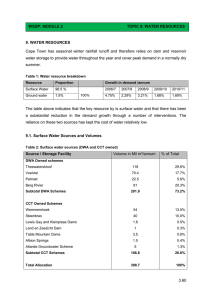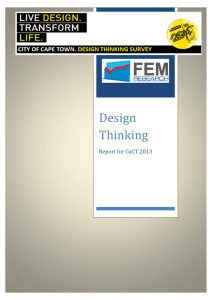WATER SERVICES DEVELOPMENT PLAN FOR CITY OF CAPE TOWN 2012/13-2016/17
advertisement
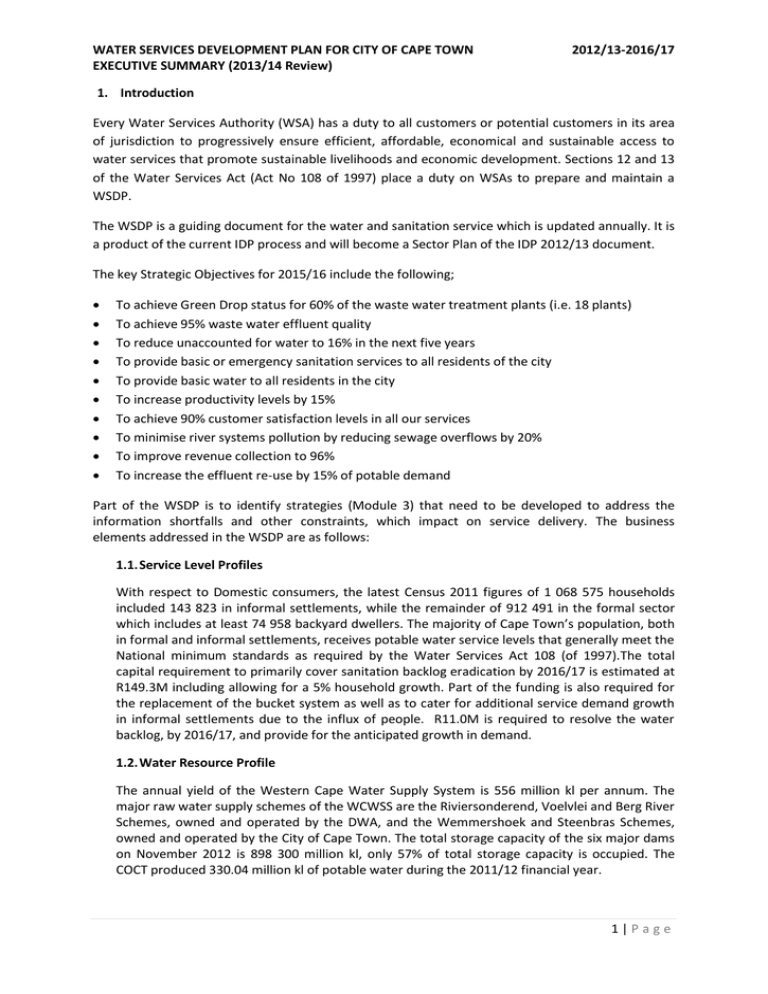
WATER SERVICES DEVELOPMENT PLAN FOR CITY OF CAPE TOWN EXECUTIVE SUMMARY (2013/14 Review) 2012/13-2016/17 1. Introduction Every Water Services Authority (WSA) has a duty to all customers or potential customers in its area of jurisdiction to progressively ensure efficient, affordable, economical and sustainable access to water services that promote sustainable livelihoods and economic development. Sections 12 and 13 of the Water Services Act (Act No 108 of 1997) place a duty on WSAs to prepare and maintain a WSDP. The WSDP is a guiding document for the water and sanitation service which is updated annually. It is a product of the current IDP process and will become a Sector Plan of the IDP 2012/13 document. The key Strategic Objectives for 2015/16 include the following; To achieve Green Drop status for 60% of the waste water treatment plants (i.e. 18 plants) To achieve 95% waste water effluent quality To reduce unaccounted for water to 16% in the next five years To provide basic or emergency sanitation services to all residents of the city To provide basic water to all residents in the city To increase productivity levels by 15% To achieve 90% customer satisfaction levels in all our services To minimise river systems pollution by reducing sewage overflows by 20% To improve revenue collection to 96% To increase the effluent re-use by 15% of potable demand Part of the WSDP is to identify strategies (Module 3) that need to be developed to address the information shortfalls and other constraints, which impact on service delivery. The business elements addressed in the WSDP are as follows: 1.1. Service Level Profiles With respect to Domestic consumers, the latest Census 2011 figures of 1 068 575 households included 143 823 in informal settlements, while the remainder of 912 491 in the formal sector which includes at least 74 958 backyard dwellers. The majority of Cape Town’s population, both in formal and informal settlements, receives potable water service levels that generally meet the National minimum standards as required by the Water Services Act 108 (of 1997).The total capital requirement to primarily cover sanitation backlog eradication by 2016/17 is estimated at R149.3M including allowing for a 5% household growth. Part of the funding is also required for the replacement of the bucket system as well as to cater for additional service demand growth in informal settlements due to the influx of people. R11.0M is required to resolve the water backlog, by 2016/17, and provide for the anticipated growth in demand. 1.2. Water Resource Profile The annual yield of the Western Cape Water Supply System is 556 million kl per annum. The major raw water supply schemes of the WCWSS are the Riviersonderend, Voelvlei and Berg River Schemes, owned and operated by the DWA, and the Wemmershoek and Steenbras Schemes, owned and operated by the City of Cape Town. The total storage capacity of the six major dams on November 2012 is 898 300 million kl, only 57% of total storage capacity is occupied. The COCT produced 330.04 million kl of potable water during the 2011/12 financial year. 1|P age WATER SERVICES DEVELOPMENT PLAN FOR CITY OF CAPE TOWN EXECUTIVE SUMMARY (2013/14 Review) 2012/13-2016/17 It is anticipated that the existing resources supplying COCT will be sufficient up to 2019. This does mean that the COCT needs to be successful in implementing the WCWDM Strategy. As part of the Reconciliation Strategy, the COCT and DWA are planning for the implementation of next water resource schemes to supply COCT. Water Compliance has exceeded the target of 96% at 98.6% (4th Quarter SDBIP, 11/12). 1.3. Water Demand Management and Strategy The levels of demand reduction planned for to a level of no more the 2% growth. This target has been far exceeded at -1.8% (negative growth/reduction in water demand) for 2011/12 financial year. If funding on WDM is not continually prioritised to enable the planned programmes, the factors of economic growth and consumer behaviour will outstrip the gains made.. 1.4. Water Balance Using water and billing figures, the unaccounted-for water (UAW) for the overall supply system from Bulk Water Treated to end consumer billing is 15.3% (2011/12, as per IWA Table). The Nonrevenue Water equated to 185.04 Ml/day (67.54 million kl/annum) which is approximately 20.5%. 1.5. Water Service Infrastructure Profile A document containing the Five Year Replacement Programme for Reticulation Networks, Inclusive of Operational Improvement Proposals has been developed. Refurbishment and replacement needs for the water and sanitation network is approximately 1.2% and 0.7% respectively. Network asset maintenance is required to reduce water losses and provide for a healthy environment. Effective asset maintenance will provide for economical and high level of service provision. The water supply and wastewater reticulation networks jointly account for 75.6% of the total replacement value. The water distribution networks experienced 3 957 bursts to water mains in 2011/12 compared to 6 523 in 2010/11. 1.6. Customer Service Profile Although under stress in certain regions, necessary infrastructure is in place to ensure an adequate quality of service to formal households. All customers receive water that is fully treated. There are mechanisms in place to attend to customer complaints and queries. Customer satisfaction addresses the ability of the department to provide basic services to all residents in the City, eradication of sanitation backlogs, provision of affordable service, meeting Service Charter standards, level of service and standard of service. The department seeks to provide services to backyarders on a direct basis in agreement with the landowners such as the Directorate of Human Settlements and private household owners. 1.7. Finance Capital expenditure incurred during the year 2011/12 amounted to R605.2 million with an expenditure level reached against the current budget. In 2010/11 operating costs amounted to approximately R4.9 billion and a deficit of some R45m. The deficit can mainly be contributed to the increasing expenditure commitments required for operations. The proposed capital budget for Water and Sanitation services are R992.3 M for 2013/14, R1074.23 M for 2014/15 and R1 327.49 M for 2015/16. Tariff increases have been set higher than inflation during the last number of years due to the escalated focus on repairs and maintenance of current infrastructure as well as the growth in the capacity requirement in the capital infrastructure programme. 2|P age
